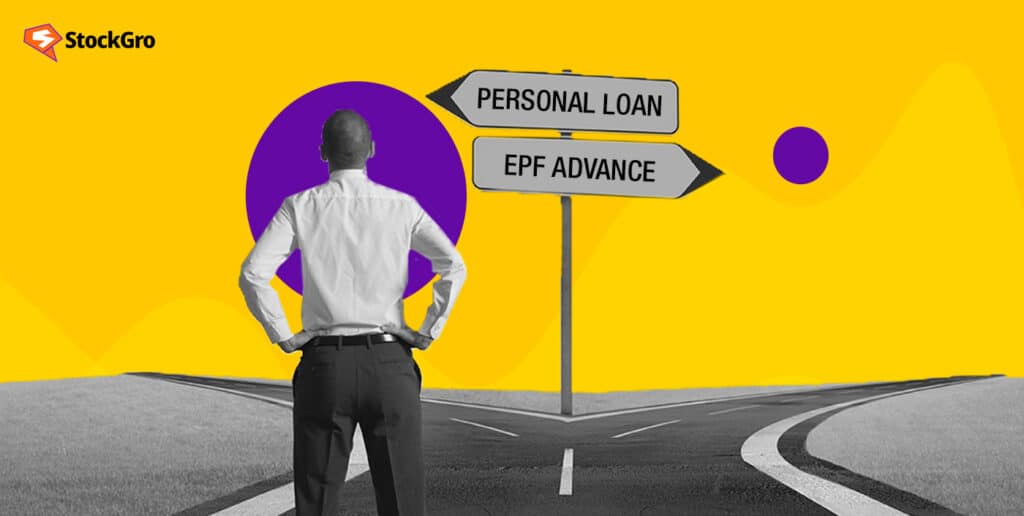
Trying to choose between a personal loan or withdrawing money from your EPF fund? It can be a challenging decision for sure! Personal loans offer access to the money you need now. However, you have to pay interest and fees, which adds up. At the same time, tapping your hard-earned retirement savings might feel like using your own cash, yet can impact the future growth of your nest egg. Read on to learn the difference between EPF advance vs personal loan.
What is a personal loan?
A personal loan implies to money borrowed from a bank or financial institution that can be used for multiple personal purposes. These loans are handy for financing major costs ranging from home renovations, destination weddings, medical treatments, or other requirements an individual may have. The amount approved as a personal loan, along with factors like applicable interest rates, fees and repayment timeline, would depend on criteria set by the lending organisation.
These are usually based on applicants’ income levels, and creditworthiness gauged through credit scores and past repayment history on loans or credit card bills. Unlike certain other forms of borrowing, personal loans are relatively quick and convenient to secure.
Personal loan advantages
- Collateral-free: A key benefit is no mortgaging of assets is required to avail a personal loan. This enables faster processing as no valuations or legal procedures are needed. It also retains complete ownership and freedom to use your assets like property or investments.
- Customisable Tenure: Repayment tenure can generally be customised from 12 months to 60 months as per your preferences and financial capability to repay. This allows you to structure the loan by choosing a comfortable EMI that fits your income and budget without putting too much monthly strain on it.
- Tax Benefits: The interest portion of EMIs can be claimed for tax deductions under Sections 80C and 80E, lowering your overall tax liability. This helps save some money on taxes by reducing taxable income each financial year through these provisions for interest payment.
- Quick Processing: Minimal documentation and eligibility criteria enable receiving approved funds in your bank account within a few days to a week. This quick turnaround is extremely useful in medical or financial emergencies when you need urgent access to liquidity, instead of waiting for weeks typical for other financing options.
What is an EPF advance?
The Employees’ Provident Fund (EPF) is a retirement corpus for salaried individuals governed by the Employees’ Provident Fund Organization (EPFO). Under the EPF program, a mandatory 12% contribution is deducted from an employee’s monthly basic pay and dearness allowance.
An EPF advance is taking a loan from your own EPF corpus before retirement for financial needs. You can withdraw up to 6 months’ basic pay + DA or 75% of the corpus value. The interest rate is affordable and offers flexibility in tenure up to 60 months. Moreover, you can initiate your EPF advance claim online through the EPFO portal to meet your urgent financial need.
You may also like: Financial Literacy and Small Business Success
EPF advantage
- Low-cost funds: The current interest rate on EPF advances is very low, around 7-8% per annum. This makes it one of the most affordable and cheapest sources of financing available. Unlike personal loans with steep interest rates going up to 26%, you get access to funds at a minimal cost here. This enables planning repayments without worrying about balloon payments due to compounding high-interest costs on reducing balance. Overall, the low rate reduces the total outflow over time. Also, you should be aware of the EPF advance withdrawal rules.
- Own savings: You borrow from the retirement corpus that you have diligently built up over the years of service. This provides a sense of security since you simply utilise your hard-earned money that can be repaid without putting too much extra pressure on your post-retirement income. The required EMI deductions also fit most salary budgets without stretching monthly finances too thin.
- Tax-free: EPF advances are entirely tax-free, thus providing you access to tax-exempt funds for your needs. This is a big blessing as you can use this money without worrying about taxes eating into it, making it effectively cheaper than other loans. Since no TDS or interest income tax applies, you can plan expenses and repayments comfortably without additional tax for each financial year, saving you the effort needed to claim refunds. Do keep a check on the EPF advance withdrawal limit.
- Minimal documentation: Only basic KYC documents like ID and address proof must be submitted, enabling speedy disbursal of advances, usually within 3-4 days. This hassle-free process reduces the time and effort needed to run around submitting income statements, salary slips, paperwork, etc. You can access money faster with little paperwork formalities for use in medical emergencies or urgent payments. The online facilities also make it easy to apply and track status.
- Flexible tenure: You can choose a repayment period anywhere from as low as 2 months up to 60 months to customise EMIs as per your capacity to repay. This allows you to structure the repayment tenor to suit your income flows and budget instead of being constrained by a rigid timeline. Whether you need short-term funds for a few months or longer-term financing, you can adapt the repayment schedule and amounts to changing circumstances. You must also know how to check EPF advance claim status.
Also read: Deciphering the numbers: Insights into the financial literacy rate in India
Key differences between personal loans and EPF advances
Here are some factors that differentiate personal loans and EPF Advances:
Interest rates
EPF advances carry 7-8% annual interest, among the lowest rates for any loan. Personal loans have 11-24% interest rates based on income, credit score, lender policies, etc. This can make EPF rates less than 1/3rd the cost of personal loans.
Repayment terms
While personal loans allow tenure of up to 5 years, EPF advances can be repaid over 5-10 years in easy EMIs deducted from the monthly salary automatically. This prevents repayment default risk associated with personal loans.
Eligibility criteria
EPF advances require minimal eligibility compliance as you borrow your own money. Anyone with at least 6 months of EPF contributions can apply. Personal loan eligibility depends on multiple factors like income, employment stability, credit score, past repayment track record, etc. Self-employed people may not be approved.
Processing time and ease of access
You can get EPF advances approval and disbursal within 2-3 days of applying through the UMANG App. On average, personal loan processing may take 1-2 weeks as banks scrutinise eligibility. EPF advances are conveniently available to all salaried employees.
Impact on financial health
Since the EMI deduction happens directly from the salary, repayment default on EPF advances is impossible. However, personal loans carry high default risks due to varied income streams or overleveraging, which can later impact credit scores and loan eligibility.
Also read: PMRY: Guide to the central government loan scheme for unemployed youth
Suitability: when to choose which
When to take a personal loan
- Meeting immediate and urgent financial needs before the next salary
- Funding small business operational expenses
- Managing temporary cash crunch situations
- Making large ticket expenditures – international holidays, etc.
When to take an EPF advance
- Accessing funds at the lowest interest rates
- Customising loan tenures from 2 months to 5 years
- Avoiding income tax by using tax-free funds
- Retaining ownership of assets without collateral
- Easy approval within days for quick liquidity
Hence, while EPF advances prove cheaper and risk-free, personal loans offer flexibility. You can choose either option based on the purpose, tenure, and costs.
Conclusion
EPF advances score higher in terms of low-cost, collateral-free funds. Personal loans come in handy for unplanned urgent expenses before payday. Carefully assess the end-use, customised tenure options, overall costs and risks before deciding. This will ensure optimising benefits while effectively leveraging these tax-efficient, affordable financing tools.

